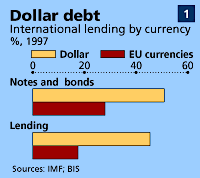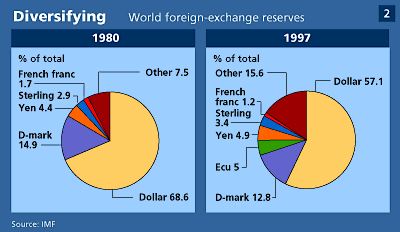|
America derives several benefits from the dollar’s dominant international role. There is, first of all, the profits to the state from its monopoly issue of notes and coins. Seignorage from dollars held abroad may be worth some 0.1% of American GDP.

The dollar’s predominance in bond markets also gives America a “liquidity discount” on government debt. The liquidity of the bond market allows the Treasury to pay a lower premium to buyers. Richard Portes of the London Business School and Helene Rey of the London School of Economics have estimated that this discount is worth between 25 and 50 basis points (hundredths of a percentage point). Given that non-residents hold about $2 trillion of American government debt, that implies an annual saving of $5 billion-10 billion, similar to the gains from dollar seignorage.

The third and perhaps biggest advantage that America gains from the dollar’s dominance is the ability to finance its current-account deficits in its own currency. Charles de Gaulle famously complained that the exorbitant privilege of the dollar “enabled the United States to be indebted to foreign countries free of charge.” In fact America pays interest on all the government debt it issues. Yet de Gaulle had a point, even so. America might have far more difficulty running huge current-account deficits if the dollar were not the international currency of choice.

Euro challenger

At the very least, the arrival of the euro might threaten America’s ability to continue reaping such benefits. But is it also possible that Europe could start to take them for itself? That depends in the first place on how quickly the euro’s international role will grow. And the answer to that will also go a long way to answering a related question: will the euro be a strong or weak currency? In particular, will it appreciate or depreciate against the dollar?

Economists considering these questions fall into two camps. In one are the enthusiasts, who reckon that the euro will be a strong and stable currency that will rapidly challenge the dollar’s predominance, largely because investors will diversify their portfolios into euros. They also think this will happen quickly—in line with the speed of today’s international capital markets.

In the other camp are the sceptics, who think the euro will need to establish a track record before investors move into it. They also reckon that inertia, for instance in reserve diversification, could benefit the dollar for several decades. They point to the lessons of history: sterling maintained its status as a globally dominant currency long after Britain’s economic hegemony was over.

Fred Bergsten, director of the Institute for International Economics, is the most prominent American enthusiast for the euro. He expects the European Central Bank to pursue a tight monetary policy. He also expects investors, and central banks, to shift a substantial part of their assets out of dollars and into euros, commensurate with the euro area’s relative economic weight.

Ultimately, Mr Bergsten thinks that around 30-40% of world financial assets will be denominated in euros, with 40-50% denominated in dollars, and the rest in yen and smaller currencies such as the Swiss franc and sterling. Such a portfolio shift could imply a one-off transfer of between $500 billion and $1 trillion into euros. And if that happens as fast as Mr Bergsten expects, it will push the euro up against the dollar.

Mr Portes and Ms Rey are also enthusiasts, though their analysis differs from Mr Bergsten’s. They argue that a key determinant of the euro’s future significance will be the transaction costs of using the euro in foreign-exchange and securities markets. As Europe’s capital and securities markets integrate, becoming deeper and more liquid, these transaction costs will fall. Lower costs will make investment in the euro more attractive, in turn increasing volume, further reducing costs, and so on.

Lower transaction costs in foreign-exchange markets will also increase the euro’s attraction as a currency for denominating trade. If there are further institutional changes in Europe’s financial markets, and if Britain, which has better developed capital markets than the continent, joins the euro, the two economists reckon that the euro could easily challenge the dollar—and again, that the challenge could come quite fast.

The sceptics’ case

How realistic are these claims? Many economists, particularly in central banks, are sceptical. They point out that the euro is still untried, and that markets will need time before they trust it as a stable store of value. More important, investors have historically shown a “home bias” in their portfolio allocation. For a net portfolio shift towards the euro to occur, foreign investors must hold more assets in euros than they did in its constituent currencies.

Nor is a single capital market entirely guaranteed. As Peter Kenen of Princeton University points out, a single currency does not mean that Europe’s bond markets will become completely unified. Although the euro will eliminate intra-European exchange-rate risk, it does not mean that German and Italian bonds become perfect substitutes. Differences in default risk and tax treatment will mean that individual bond markets remain segmented—though to the extent that they are less so than now, the euro may still gain.

Sudden shifts in official reserve holdings are also unlikely, despite the disproportionate size of the euro area’s own reserves. Once the euro is introduced, the national central banks of the euro area will hold relatively high stocks of foreign reserves that they will no longer need because much of what is now “external” trade will become intra-euro trade. Estimates of these “excess” reserves range from $50 billion to $230 billion. Central banks will at some point want to reduce these.

Other non-euro central banks (which hold a total of some $775 billion of dollar reserves) might also want to hold more euros and fewer dollars. If official dollar reserves were sold suddenly, there would clearly be downward pressure on the dollar; but central bankers will surely want to avoid doing anything to destabilise currency markets, so they are likely to move slowly. In any case, official dollar holdings are small compared with America’s overall international assets and liabilities, which, according to the IMF, are of the order of $3.5 trillion and $4 trillion respectively. What really matters, therefore, is the behaviour of private investors.

The relationship between portfolio adjustment and the euro’s exchange rate is complicated. In theory, if private demand for new euro assets matched the supply from governments and firms that will borrow in euros, there might be no effect at all. In practice, however, a substantial exchange-rate effect can be expected—mainly thanks to the pattern of current-account deficits and surpluses between America and Europe.

If demand for euro assets comes from outside Europe, the resulting inflow of capital to the region means that it would have to shift from today’s huge current-account surplus (1.8% of euro area GDP in 1997) to a big deficit to accommodate it. America, in turn, would be forced to trim radically its current-account deficit of 2.1% of GDP in 1997. Such a swing would probably be engineered by a huge change in exchange rates, with the euro rising sharply against the dollar. Moreover, if the demand for euro assets then rose faster than their supply, the euro would continue to appreciate. To give some idea of magnitudes, Mr Portes and Ms Rey have suggested that a portfolio shift of $700 billion into the euro might drive down the dollar by 40%. Such a change would, to put it mildly, have a big impact on the global economy.

The European Central Bank’s monetary policy (and also the fiscal policies of euro member governments) will, of course, influence both the demand for the euro and its price. So the biggest question of all is: will the ECB, which has a treaty obligation only to pursue price stability, take much notice of the euro’s exchange rate? Like America and Japan, the euro area will be a relatively closed economy: external trade will account for a mere 10% of GDP. It may be tempting for the Europeans to mimic the “benign neglect” that they have often accused the Americans of following for the dollar. Indeed, some economists think that, with the world’s two major currencies concentrating exclusively on domestic goals, currency instability might increase.

Hence, perhaps, the renewed calls for more formal international co-ordination. At its simplest, this might mean no more than closer co-operation among the main currency blocks—the dollar, the euro and the yen. But there have also been calls for “target zones” for the euro and other currencies—most recently suggested by Germany’s new finance minister, Oskar Lafontaine, in talks with his French opposite number, Dominique Strauss-Kahn, though the motivation of both men seems to be to ensure that the euro does not appreciate too far rather than a sudden conversion to the notion of target zones for the good of the world economy.

Formal exchange-rate targets seem infeasible, even if some co-ordination between the world’s major currencies might be desirable. For one thing, it is hard to see them working for the euro, given the confusion over responsibility for it in international arenas (see article). Nonetheless, a lesson of the 1930s is that the existence of two semi-dominant currencies (in that case, the pound and the dollar) can be destabilising. Third countries, in particular, can suffer from large currency swings. The challenge facing the Europeans (and others) will be to harness the benefits of their increasingly important new currency, while at the same time minimising the risk of any such negative global consequences.



|


